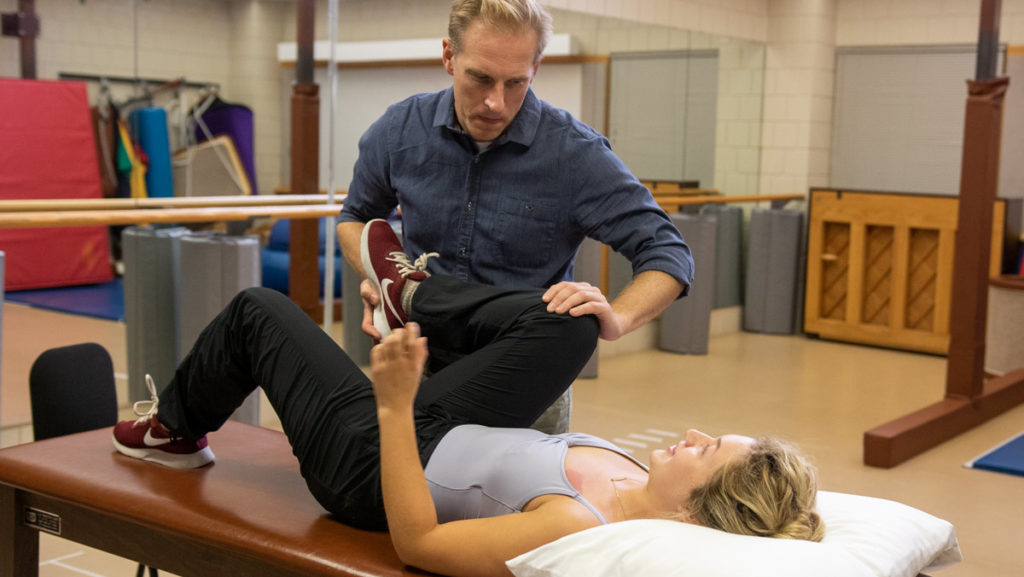Every Friday from 10 a.m. to noon on the fourth floor of the Center for Health Sciences, the Ithaca College physical therapy and occupational therapy departments hold free injury evaluations for performing arts students.
The performing arts clinic treats musicians, dancers and any sort of actor or performer. Sports that are more aesthetically oriented like figure skating and gymnastics also fall into this category. Mike Costello, assistant professor in the Department of Physical Therapy, who oversees the clinic, said the clinic is the intersection between performing arts and sports medicine.
“The clinic is focused on any performer with performance-limiting conditions,” Costello said. “The classic example is the violin player who is saying, ‘I can’t figure out why my left shoulder hurts.’ With musicians, it’s generally what kind of what we call upper neck, arm and back pain. With dancers, it can really be anything, but is more commonly lower back, hip, knee, foot and ankle conditions.”
Costello took over the clinic from Nick Quarrier, retired clinical associate professor in the Department of Physical Therapy, who Costello had as a professor 20 years ago. Costello said he personally has an interest in performing arts because he is a classically trained musician and is active in the local music scene, playing the bass and guitar.
Costello said students do not have to schedule appointments for the walk-in clinic. He said most people come in with musculoskeletal conditions, which are disorders that affect the human body’s movement or musculoskeletal systems like sprains and back pain. He decides the severity of the injury within a couple of meetings.
“The concept there is to help triage these students,” Costello said. “Is this person coming in with some sort of serious medical condition that needs to be assessed by a physician? So my job is to screen and facilitate that.”
Costello said the clinic is a good experience for the physical therapy students who are interested in performing arts physical therapy. He said there are both sessions run by himself and sessions he has exclusively scheduled with physical therapy students.
“The walk-in clinics itself is very evaluation-oriented, so it encourages students to really work on their evaluation and overachievement skills,” Costello said. “It also encourages students to work on their life prioritization skills because you can’t test everything under the sun, right? You’ve got to make a decision, and that’s where it differs from a more regular clinic session.”
Costello said students’ visits to the clinic are kept confidential.
Jaleel Green, a fifth-year physical therapy graduate student, is one of the student physical therapists who helped evaluate and treat students who came to the clinic last spring. He said the most interesting thing about the clinic was seeing how many of the students came in with similar injuries but got them in different ways.
Green said he is working on getting his footing within his field of study and building up his confidence.
“I am learning a lot about how to organize a treatment session, how to problem solve during the sessions and how to feel more confident when working with the patients that come into the clinic,” Green said.
Samantha Seidita, a fifth-year physical therapy graduate student who worked at the clinic last semester, said she is looking forward to her future as a physical therapist and working in pediatric performing arts.
“When I think about my future as a practicing physical therapist, I do have an interest in treating performing artists as I am a dancer myself,” Seidita said. “I also have an interest in working with a pediatric population, so I would potentially love to work with pediatric performing artists. ”
Green also said he would love to work with performing artists in the future.
“I’d love to work with the Alvin Ailey dance company, travel with Broadway shows or even work with the performers for Cirque du Soleil,” Green said.
Costello said that while he has mainly run the clinic on his own this semester, he plans on integrating it into the curriculum more in the future. He said he reached out to different music and athletics departments to combine forces with the goal of preventing these types of injuries in the future.
“I have oftentimes gone with either myself or with students to a dance or music class and talked about injury prevention principles,” Costello said. “So that’s kind of the other side of it, which goes along with the saying ‘an ounce of prevention is better than a pound of cure.’”








